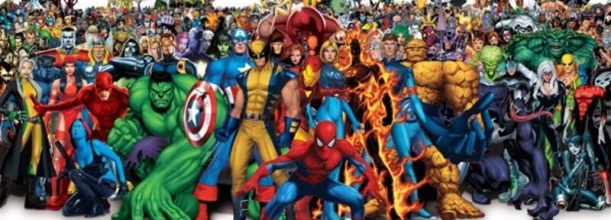The fall and rise of the cinematic superhero

I vividly remember X-Men coming out in 2000 – I was, after all, an eleven year old boy, and we were all about that sort of thing. In fact, now I come to think about it (and trawl Wikipedia), I can remember Spiderman swinging onto our screens in 2002, and not only Hulk but the entire League of Extraordinary Gentlemen making their various green and sexist appearances in 2003. And then there was Blade: Trinity in 2004… D’you see what I’m getting at? Superhero films are big, big, BIG business, and the last decade’s worth of cinema has seen so many unitards and tooled leather boots I’m surprised it hasn’t run off to join the chorus line of Priscilla, Queen of the Desert. The days of the latest capering crusader being consigned to the 80s bargain bin alongside Surf Nazis Must Die! and Over-sexed Rugsuckers from Mars (both real titles – check them out or die unfulfilled) are long over.
The question is this: why and how did superheroes break back through the Kryptonite ceiling and onto the big screen? There are certainly those who dismiss the hyper-successful new breed of franchises – the X-Men & Spiderman trilogies and Christopher Nolan’s Batman epics chief among them – as overproduced pap which appeal to audiences because they are morally uncomplicated, visually stunning and laden with celebrities. Some films – Catwoman, Daredevil and, heaven preserve us, Electra spring to mind – undoubtedly subscribe to this formula without a qualm, and we should be ruthless in dismissing them as insipid bollocks, but I think dismissing an entire genre on the basis of an uncultured and vulgar minority would be no better than deciding everyone under the age of eighteen is a knife-wielding psychopath who has simply not had the opportunity to wield a knife yet. Superhero films deserve some serious thought.
To the Bat-Chilled Water Dispenser!
It’s impossible to avoid drawing a certain number of parallels between the ever-increasing potential of cinematographic special effects and the concurrent rise in popularity of superhero films.  Within a genre which requires such substantial suspension of belief, a masterpiece of technical dexterity such as The Dark Knight will of course be more watchable than the cringeworthy 1966 production of Batman: The Movie, in which the Caped Crusader’s encounter with a motionless rubber shark gives Robin an excuse to consult his rack of branded Oceanic Repellent Batsprays – available now in a choice of Shark, Whale, Barracuda and Manta-Ray! If Christian Bale ever comes up against a shark whilst on a rope ladder – unlikely – he’ll just punch it until it falls unconscious into the ocean and drowns because it can’t force water through its gills. Much more realistic, even if it does get Peta riled up, and the beauty of the strategy is that he can then just punch them until they fall in the sea too. It’s the perfect crime!
Within a genre which requires such substantial suspension of belief, a masterpiece of technical dexterity such as The Dark Knight will of course be more watchable than the cringeworthy 1966 production of Batman: The Movie, in which the Caped Crusader’s encounter with a motionless rubber shark gives Robin an excuse to consult his rack of branded Oceanic Repellent Batsprays – available now in a choice of Shark, Whale, Barracuda and Manta-Ray! If Christian Bale ever comes up against a shark whilst on a rope ladder – unlikely – he’ll just punch it until it falls unconscious into the ocean and drowns because it can’t force water through its gills. Much more realistic, even if it does get Peta riled up, and the beauty of the strategy is that he can then just punch them until they fall in the sea too. It’s the perfect crime!
The superhero films of the 60s and 70s couldn’t come close to bringing alive the exploits which played out in comic books across the world, so after a while they stopped trying.  Superhero films became more and more camp and self-referential, with the nadir of the entire genre arguably being the homoerotic and tongue-in-cheek Batman and Robin, inexplicably starring Val Kilmer as a Batman whose suit was either a little bit chilly or a big bit aroused. Tim Burton’s period at the helm of the Batman franchise had been a marginal improvement, but the films remained comedy with a side order of creepiness rather than anything more adult. The Superman films also went into freefall after a promising start in 1978, with the catastrophic Superman IV: The Quest for Peace banishing the Man of Steel to his silly little igloo for the next nineteen years. These pantomimes were embarrassing and intellectually bankrupt rubbish – the serious and well-constructed comic book characters became puppets who danced through a world principally calculated to provide maximum merchandising potential. Superheroes were B-movie fodder, and likely to stay that way.
Superhero films became more and more camp and self-referential, with the nadir of the entire genre arguably being the homoerotic and tongue-in-cheek Batman and Robin, inexplicably starring Val Kilmer as a Batman whose suit was either a little bit chilly or a big bit aroused. Tim Burton’s period at the helm of the Batman franchise had been a marginal improvement, but the films remained comedy with a side order of creepiness rather than anything more adult. The Superman films also went into freefall after a promising start in 1978, with the catastrophic Superman IV: The Quest for Peace banishing the Man of Steel to his silly little igloo for the next nineteen years. These pantomimes were embarrassing and intellectually bankrupt rubbish – the serious and well-constructed comic book characters became puppets who danced through a world principally calculated to provide maximum merchandising potential. Superheroes were B-movie fodder, and likely to stay that way.
The end of the superheroic superhighway?
We know the rest – in 2000 Bryan Singer’s X-Men was a massive surprise hit and producers started to realise that if you left the money tap open over a superhero production budget, you’d get it back in buckets. But I don’t think it’s fair to assume superhero films have only enjoyed a resurgence because they’re pretty. Superhero films are the latest generation of a millennia-old tradition – the veneration of heroic figures because they embody the qualities we both prize and lack.  The word ‘hero’ originally referred to a demi-god, a human with supernatural powers or divine assistance which raised him above the common clay to perform extraordinary feats – look at Heracles or Perseus, Greek heroes whose ethereal heritage propelled them to classical superstardom. Later on we see stories like the Odyssey, the epic which tells the story of the eponymous Odysseus and his ten-year journey home from the ruins of Troy. Odysseus is a clear template for Batman – although he is without supernatural powers and many of his enemies are packing a severe magical punch, his wily cunning and heroic virtue see him carve a swathe through the assorted baddies of the Aegean. What about a thirteenth century Spiderman, bereft of web-ducts but with an identical remit of fighting corruption and protecting the common man? Step forward, Robin Hood! We can even draw a parallel with the hagiographies or lives of the saints which have always been popular within the Catholic Church – a more specialised heroic appeal, perhaps, but inspiring and strengthening for believers nonetheless. Whether they’re folk heroes like Finn McCoul or legendary figures like King Arthur, we’ve been pinning our hopes on not-quite-real superbeings for as long as our lives have been dangerous, threatening or in any other way not as they should be.
The word ‘hero’ originally referred to a demi-god, a human with supernatural powers or divine assistance which raised him above the common clay to perform extraordinary feats – look at Heracles or Perseus, Greek heroes whose ethereal heritage propelled them to classical superstardom. Later on we see stories like the Odyssey, the epic which tells the story of the eponymous Odysseus and his ten-year journey home from the ruins of Troy. Odysseus is a clear template for Batman – although he is without supernatural powers and many of his enemies are packing a severe magical punch, his wily cunning and heroic virtue see him carve a swathe through the assorted baddies of the Aegean. What about a thirteenth century Spiderman, bereft of web-ducts but with an identical remit of fighting corruption and protecting the common man? Step forward, Robin Hood! We can even draw a parallel with the hagiographies or lives of the saints which have always been popular within the Catholic Church – a more specialised heroic appeal, perhaps, but inspiring and strengthening for believers nonetheless. Whether they’re folk heroes like Finn McCoul or legendary figures like King Arthur, we’ve been pinning our hopes on not-quite-real superbeings for as long as our lives have been dangerous, threatening or in any other way not as they should be.
Modern superheroes for a modern threat
In 2000 the time was ripe for superhero films to make a comeback – technology had at last caught up with our imaginations, and for the first time the cinema could make explicit what could only be implied in a comic. However, I think there was more to it than that – at the dawn of this millennium the Western world was faced with threats inconceivable to the post-war generation who watched Batman fight his rogues’ gallery of improbable megalomaniacs. Is it any coincidence that Robert Downey Jr.’s first opponents as Iron Man were anti-American terrorists, or that Heath Ledger’s Joker was an anarchist who “just want[ed] to watch the world burn”? S.P.E.C.T.R.E. and the Legion of Super-Villains are old news – today’s superheroes were reimagined because for the first time since the Second World War we faced a threat more tangible than the indistinct shadow of the Evil Empire. I expect that if I was a bit of a tool I could cite Freud on our need for an intangible, all-powerful father figure, or Jung on the archetypal hero who embodies the ego and saves the maiden from the dragon, but fortunately I’m not a tool.
However much you psychoanalyse it, the fact of the matter is this. We empathise with superheroes because they face our problems – bullies, prejudice, apathy – but on a giant scale and with the sort of courage and ingenuity we mortals can only dream of. As the USSR collapsed and the Communist threat receded for the first time in two generations, our interest in superheroes stagnated along with our general levels of anxiety; but once all that pesky imperialism came back to bite us in the collective colonial arse we were right back in the cinema, basking in the protective glow of our latter-day demigods. In an uncertain world, we know superheroes are incorruptible and that they’ll ultimately triumph, and that they shine as a beacon of hope for anyone who’s wondered if they’ll ever look good in Spandex. Far from being overgrown cartoons for overgrown kids, superbeings are the legitimate successors to an age-old tradition of heroism which we need now as much as we ever did.





Recent Comments